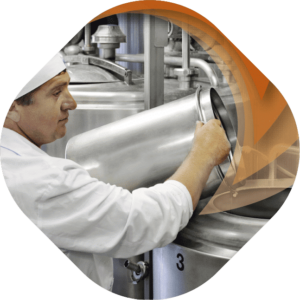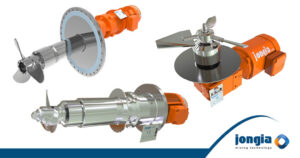
Milk
Milk is the liquid produced by the mammary glands of mammals. Milk can come from any mammal but cows, goats, buffalo and sheep are the most common and well-known producers.

For the best mixing solution we rely on our process knowledge of more than 80 years and our high quality sanitary design

What is milk?
Whole milk (also often called plain milk) contains about 87% water. The remaining 13% contains protein, fat, carbohydrates, vitamins and minerals. Within the production of milk, there are several techniques that ensure the milk contains less fat. These techniques make it possible to produce skimmed and semi-skimmed milk.
Between these three types of milk, skimmed milk contains the least fat, semi-skimmed milk contains slightly more fat than skimmed milk, and whole milk has the most fat.
Pasteurized, sterilized and raw milk
Pasteurized milk is raw milk that has been heated to a certain temperature and time to kill pathogens in the raw milk. Pathogens are microorganisms such as bacteria that make us sick. Raw milk can contain pathogens such as Campylobacter, E. coli O157:H7, Salmonella, Listeria and other bacteria.
With sterilized milk, all bacteria are killed because the milk is heated to temperatures above one hundred degrees. As a result, sterilized milk also has a much longer shelf life and can be left outside the refrigerated section. Long heating gives the milk a different taste than pasteurized milk.
Raw cow’s milk is milk that is completely unprocessed, it still contains various bacteria and fats and no fats have been extracted yet.
Frequently Asked Questions
What is the composition of milk?
Milk is primarily made of about 87% water, while the remaining 13% consists of proteins, fats, carbohydrates, vitamins, and minerals. Different techniques in production allow for variations, resulting in skimmed milk with the least fat, semi-skimmed with more, and whole milk containing the most fat.
What is pasteurized milk?
Pasteurized milk is raw milk that has undergone heating to a specific temperature for a set duration to eliminate harmful pathogens. This process improves safety, reducing the risk of illness caused by bacteria commonly found in raw milk.
How is sterilized milk different from pasteurized milk?
Sterilized milk is heated to temperatures exceeding 100 degrees Celsius, killing all bacteria, resulting in a much longer shelf life. Unlike pasteurized milk, sterilized milk may have a different taste due to the extended heating process.
What are the benefits of organic milk?
Organic milk is produced with a focus on the welfare of cows and minimal environmental impact. This method promotes better animal conditions and aims to reduce detrimental effects on the planet, making it a sustainable choice for consumers.
What dairy products can be made from milk?
Milk serves as a base for various products, including cheese, yogurt, butter, and ice cream. Each product varies in composition and treatment, showcasing the versatility of milk in creating numerous consumer goods and ingredients for culinary use.
Food & Beverages Contacts

Tom Pruymboom
Sales Director
Area Worldwide

Bart Brouwer
Area Sales Manager
Area Worldwide

Sijko van der Veen
Application Engineer
Technical Specialist
Dairy – Related Articles

The introduction of crystallization in the mixing process for the dairy industry
Jongia Mixing Technology has initiated numerous mixing processes all over the world using her agitators. In some of these mixing processes, crystallization was a key factor in acquiring the desired final product. The process of crystallization is well-known in the

The Jongia Magitator: A multi-purpose magnetic agitator
To keep dairy or starch products homogeneous, the Jongia Mixing Technology Magitator, a magnet-driven agitator, is the right choice. In addition, this agitator maintains vegetable oil or juices at the right temperature. USP’s of the Magitator Opting for the Magitator

Jongia propellers are a valuable addition to the mixing process
Product friendly propellers are an indispensable part of our customers’ mixing process. Especially in the dairy industry, where slightly viscous liquids are mixed, it is very important that the products are not damaged during the mixing process. Jongia has unique
Types of milk products
Consuming milk can be done in many different ways. Besides the packs of liters of milk you find in the super market, there are also very many other milk products.
- Chocolate milk comes from skimmed, semi-skimmed and whole milk. This milk is mixed with cocoa, sugar and various aromatic and flavoring substances. For fresh milk, cocoa powder is often added.
- Organic milk is produced in a better and kinder way for the cow. It has a lower impact on the animal and environment which in turn is better for the planet.
- Condensed milk is milk with sugar added because of these sugars, condensed milk is a very long-lasting milk. This milk can be kept unrefrigerated and is often found in cans.
- Ice cream consists mainly of skimmed milk and cream. There is also ice cream made from yogurt or buttermilk.
- Butter milk is created by the acidification of milk. Buttermilk contains live lactic acid bacteria and contains less than 1% fat.
Dairy products
Milk is the basis for many different products. Roughly divided in the following product groups;
- Consumer products (milk, yoghurt, desserts etc)
- Cheese & butter
- Ingredients
Jongia agitators are used for all these different dairy applications with a clear focus on sanitary design and product knowledge.
It already starts at the (raw) product storage silos, required at every production facility. Mainly milk, cream and whey concentrate products. The majority of these tanks is agitated by means of a Jongia side entry agitator type JDRW. An efficient, low budget solution for product storage.
Some of the most important products at the moment are whey and cream products. Both can be seen as a by-product from cheese production, but with a very important economic value. Specially whey products are booming business at the moment.
The whey liquid is separated from the cheese curd at the final stage, just before putting it in the cheese moulds. This product (with a rather low dry solids concentration) is stored in tank silos, agitated by a side entry type JDRW. In following steps the whey is concentrated further to a higher ds content by means of separation and/or evaporation. At this stage the product is agitated by means of a slow running agitator type LD, in order to keep a good suspension.
In the past whey concentrate was mainly used as animal feed. This is still one of the applications (base material for animal feed). But it can also be used for numerous other products (with higher economic value), like lactose and whey powders. These powders are used in for instance baby food, drinks, soups, pharmaceutical applications etc. Jongia LD type agitators are used for storage and/or blending applications in all kinds of applications.
A special application is crystallization of whey/lactose liquids. This requires close consultancy with the clients product specialist, In order to get the required crystallization results.
Cream, an other cheese by-product, is separated from the (raw) milk, in order to get a standardized milk quality for the cheese production. It is stored in cooled silos, and in general agitated by means of a slow running agitator type LD. Fat content in general 30-42%. Large, slow running mixing blades provide an optimal cooling (for taking away possible crystallization heat) without damaging the cream.
Cream used for butter production may also require a crystallization step, called cream ripening. The cream is slowly heated and cooled to the required temperature, and the agitator gently homogenizes the bulk liquid. The required agitator is a special type LD agitator, optimized for this ripening process. Once again close consultancy with the clients product specialist is required, to get the desired results.
Cream is not only used for butter production. Other applications are food products, like culinary creams, and butter oil/serum. These last are agitated by means of a Jongia agitator type JDR.
References for above mentioned processes are amongst others:
FrieslandCampina, DOC/Volac Nutrition, Arla Foods UK, Glanbia Ireland, VIV Zelhem












